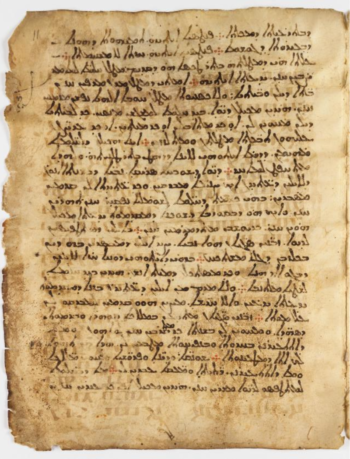As stories spread about the discovery of this long-lost map of the constellations in an

ancient biblical codex, Museum of the Bible has more light to shed on the history and context of this exciting discovery.
“Hidden beneath the Syriac text of John Climacus’s Ladder of Divine Ascent is a Greek text derived from the astronomer Hipparchus’s Star Catalogue,” said Brian Hyland, the museum’s associate curator of medieval manuscripts. “The newly-discovered text is a remarkable breakthrough that highlights the creative use ofmultispectral imaging technology to read previously lost texts. It also attests to the accuracy of Hipparchus’s measurements.”
The star map document’s origins go back to the fifth or sixth century, when a Greek scribe created a copy of the astronomer Hipparchus’s catalog of the stars, mentioning the position of the stars in the constellation Corona Borealis (Northern Crown). In the tenth or eleventh century, a scribe at St. Catherine’s Monastery at Mt. Sinai was looking for some usable vellum to record something else and recycled some leaves, or pages, from some older manuscripts.
This ancient recycling was done by scraping off the existing ink and washing the vellum. The scribe gathered leaves from at least ten different old manuscripts, one of which was the star catalog, and wrote a Syriac translation of John Climacus’s works on the newly cleaned vellum. Over time, the acids in the ink of the original text began to darken, which allowed people to see that this manuscript contained text underneath the more recently written text. This manuscript was, therefore, a palimpsest, or piece of writing material used multiple times.
The manuscript remained at St. Catherine’s until the late 19th century, when the twin “Sisters of the Sinai,” Agnes Smith Lewis and Margaret Dunlop Gibson, traveled to Egypt in search of ancient manuscripts, especially palimpsest manuscripts. Between 1895 and 1906, they acquired the 137 leaves now in the Museum of the Bible’s collection, plus one leaf currently at the University of Birmingham, UK.
In 2013 and 2015, the museum arranged for multispectral imaging of a few of the leaves. Then in 2017 and 2018, all of the museum’s leaves were imaged this way. By processing these images with various tools, the older text that had been obscured or only faintly visible could be made clearer. These images were sent to Cambridge University for study as part of the museum’s Scholars Initiative program, which arranged with Dr. Peter Williams and a group of scholars at Tyndale House to study the leaves and publish the contents of the undertext. Led by Williams, Tyndale House Cambridge is a research institute housing one of the world’s most advanced libraries for biblical scholarship.
The Codex Climaci Rescriptus is on display at the Museum of the Bible for visitors to see. Photographs from the collection are available online.
About Museum of the Bible
Museum of the Bible is a global, innovative, educational institution whose purpose is to invite all people to engage with the transformative power of the Bible. Making its grand opening to the public in November 2017, Museum of the Bible’s 430,000-square-foot building is located just three blocks from the U.S. Capitol in Washington, D.C. Museum of the Bible aims to be among the most technologically advanced and engaging museums in the world. Showcasing rare and fascinating artifacts spanning 4,000 years of history, the museum offers visitors an immersive and personalized experience with the Bible and its ongoing impact on the world around us. For more information, visit museumoftheBible.org.



